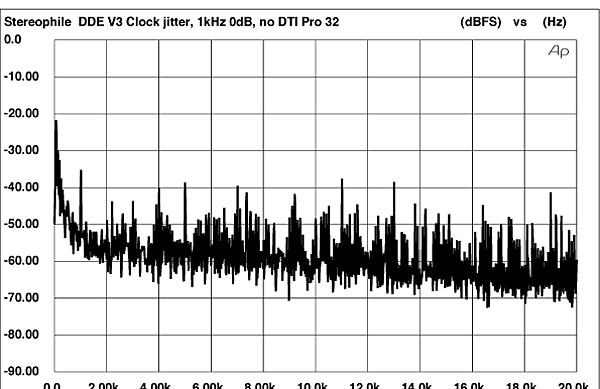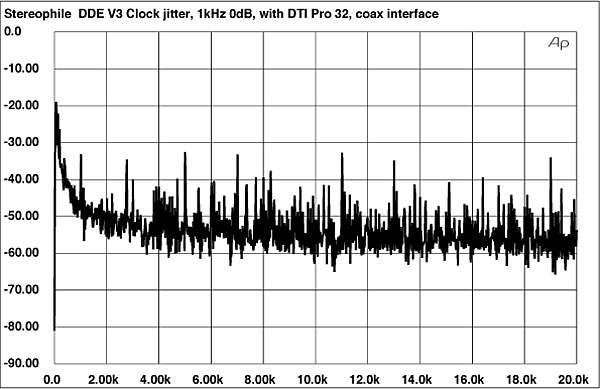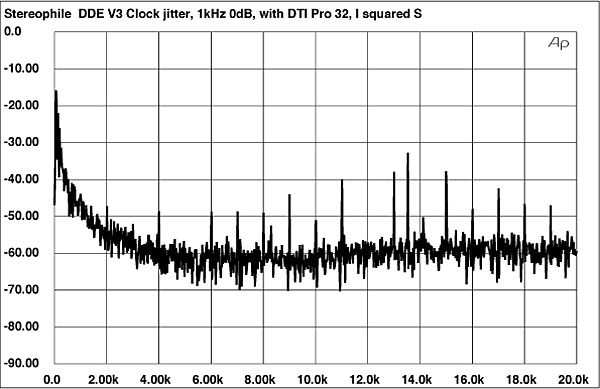| Columns Retired Columns & Blogs |
Audio Alchemy DTI•Pro 32 Jitter Filter Measurements
Sidebar 2: Measurements
I started by looking at the DTI•Pro 32's effect on low-level signals alternately in bypass mode, and then with the Resolution Enhancement processing engaged. I performed wideband third-octave spectral analysis, waveform capture, and FFT-derived spectral analysis on a variety of signals, but saw no difference in the noise level, noise-floor spectrum, or even the presence of dither. I also tried to measure the DTI•Pro 32's effect by looking at the output of the DDE v3 processor with and without the DTI•Pro 32 in the signal path. Again, the DDE v3's low-level waveforms, noise-floor, and noise spectrum were identical with and without the DTI•Pro 32. So much for seeing what resolution enhancement does. Perhaps Audio Alchemy can provide some measurements in their Manufacturer's Comment, or suggest tests that would reveal the effect of Resolution Enhancement.
I was able, however, to measure the DTI•Pro 32's effect on the word-clock jitter inside a digital processor fed from the Pro 32. Specifically, I measured the DDE v3's clock jitter, then the clock jitter with the DTI•Pro 32 with a coaxial interface, and finally the DDE v3's clock jitter when fed from the Pro 32's I2S interface. The jitter analyzer was the Meitner LIM Detector operating over a measurement bandwidth of 400Hz–20kHz. Note that the RMS jitter levels shown here are slightly lower than what I measured in the DDE v3 when I evaluated Audio Alchemy's DTI v2 jitter filter, probably because this was a later production sample of the v3.
Fig.1 is the DDE v3's clock jitter when fed from a PS Audio Lambda transport playing the 1kHz, 0dB tone from the CBS Test CD. Note the periodic jitter components at 1kHz and multiples of 1kHz. This signal-correlated jitter (the clock is jittered at the same frequency as the audio signal being processed) is largely caused by the S/PDIF interface between the Lambda transport and the DDE v3. The RMS jitter level was a highish 220 picoseconds. The same measurement, but with the DDE v3 driven by a 1kHz –90dB sinewave, is shown in fig.2. The signal-correlated jitter components are much higher in level, as would be expected with this low-level signal. The RMS jitter level rose to 275ps.

Fig.1 Audio Alchemy DDE v3, word-clock jitter spectrum, DC–20kHz, while processing 1kHz sinewave data at 0dBFS; PS Audio Lambda transport (linear frequency scale, 10dB/vertical div., 0dB = 1ns).

Fig.2 Audio Alchemy DDE v3, word-clock jitter spectrum, DC–20kHz, while processing 1kHz sinewave data at –90dBFS; PS Audio Lambda transport (linear frequency scale, 10dB/vertical div., 0dB = 1ns).
Adding the DTI•Pro 32 to the signal path, and connecting the DDE v3 via a coaxial connection, reduced the RMS jitter levels and slightly cleaned up the spectrum. Fig.3 is the DDE v3's clock jitter when decoding a 1kHz, 0dB sinewave with the Pro 32 in the signal path. Comparing fig.3 to fig.1, we can see that the Pro 32 actually seemed to raise the amplitude of the periodic jitter components, although the Pro 32 reduced the RMS jitter level from 220ps to 165ps. Fig.3 (with DTI•Pro 32) also shows a reduced number of periodic components; the plot is less dense with spikes.

Fig.3 Audio Alchemy DDE v3, word-clock jitter spectrum, DC–20kHz, while processing 1kHz sinewave data at 0dBFS; PS Audio Lambda transport with DTI•Pro 32 connected via coax interface (linear frequency scale, 10dB/vertical div., 0dB = 1ns).
Fig.4 is the DDE v3's clock jitter with the DTI•Pro 32 and coaxial interface, but with a 1kHz –90dB sinewave test signal. Compared to fig.2 (the same signal, but no DTI•Pro), we can see that the Pro 32 changed the jitter spectrum, but had little effect on the number or amplitude of periodic jitter components. Again, however, the Pro 32 reduced the RMS jitter amplitude from 275ps (no DTI•Pro 32) to 180ps.

Fig.4 Audio Alchemy DDE v3, word-clock jitter spectrum, DC–20kHz, while processing 1kHz sinewave data at –90dBFS; PS Audio Lambda transport with DTI•Pro 32 connected via coax interface (linear frequency scale, 10dB/vertical div., 0dB = 1ns).
Not surprising in light of the auditioning, the I2S connection between the Pro 32 and DDE v3 produced a dramatic reduction in the RMS jitter level and a much cleaner jitter spectrum. Fig.5 is the DDE v3's clock jitter when the unit was driven by a 1kHz 0dB sinewave via the Pro 32 and I2S connection. The 1kHz interface-induced jitter component is completely removed, although we can see some strong periodic components higher in frequency. The RMS jitter level dropped to just 70ps (compared with 220ps with no Pro 32, and 165ps with the Pro 32 and coaxial interface). A more dramatic example of the benefits of I2S is provided by fig.6, the DDE v3's clock-jitter spectrum when processing a 1kHz –90dB sinewave through the Pro 32 and I2S interface. Note the nearly total absence of signal-correlated jitter components and clean spectrum (except for the spike at 13.5kHz, also seen in fig.5). The RMS jitter level measured a low 77ps.

Fig.5 Audio Alchemy DDE v3, word-clock jitter spectrum, DC–20kHz, while processing 1kHz sinewave data at 0dBFS; PS Audio Lambda transport with DTI•Pro 32 connected via I2S interface (linear frequency scale, 10dB/vertical div., 0dB = 1ns).

Fig.6 Audio Alchemy DDE v3, word-clock jitter spectrum, DC–20kHz, while processing 1kHz sinewave data at –90dBFS; PS Audio Lambda transport with DTI•Pro 32 connected via I2S interface (linear frequency scale, 10dB/vertical div., 0dB = 1ns).
These measurements suggest the DTI•Pro 32 is moderately effective in reducing jitter when connected to a processor through its coaxial output, and massively effective when the I2S connection is used. I must caution you against reading too much into these measurements. The limited measurement bandwidth (400Hz–20kHz) means we're looking at only a small part of the sonically significant jitter spectrum, which extends from just a few Hz to 40kHz in a multi-bit DAC. There may be things going on outside our measurement bandwidth we can't see.—Robert Harley
- Log in or register to post comments




































